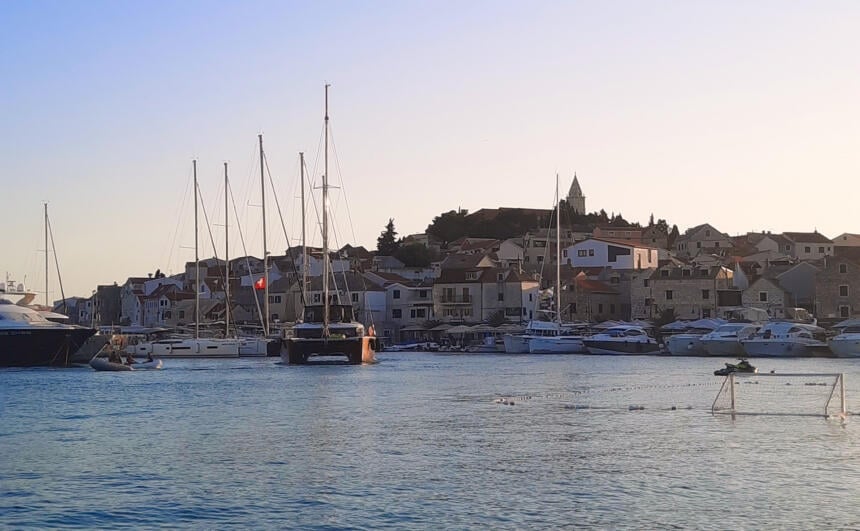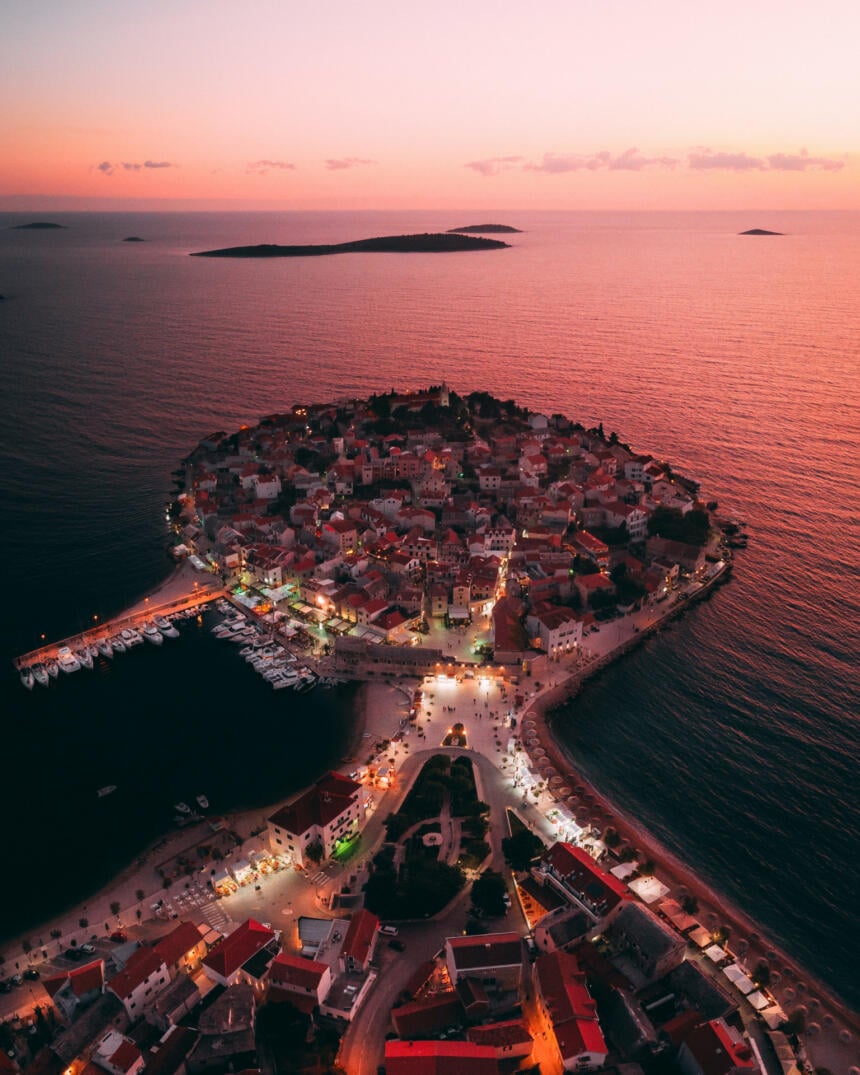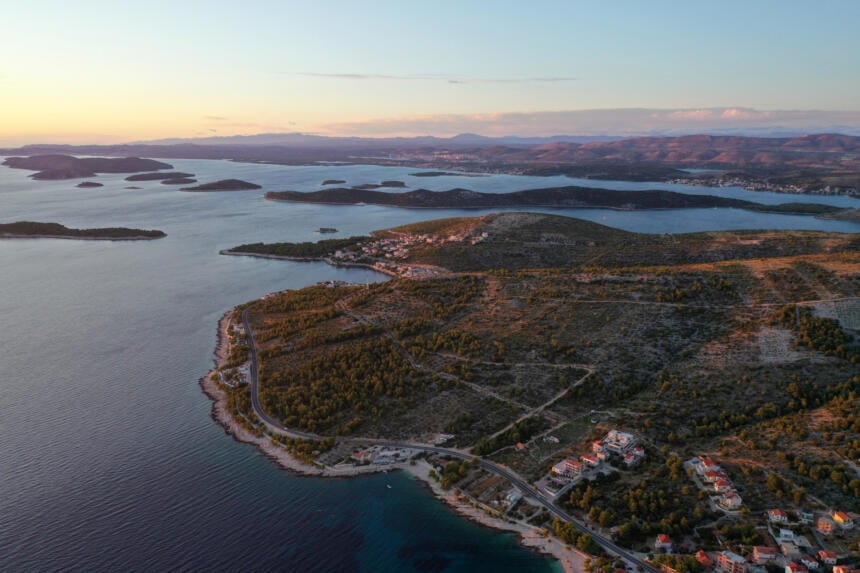Primosten, Croatia: The Ultimate Travel Guide
A small paradise with white beaches and turquoise waters! Welcome to Primosten Croatia!
A small paradise with white beaches and turquoise waters! Welcome to Primosten Croatia!
Primosten is a small village in Croatia. It was originally a small cone-shaped rocky island, connected to the mainland by a drawbridge. Later, after the Ottoman intrusions diminished, the artificial dam replaced the bridge. The origin of the name Primošten comes from the Croatian term “pri mosta” or “primostiti” which means at the bridge or to connect through a bridge.
The place has retained its Mediterranean atmosphere and all the characteristics of a fishing village. Its peculiarities are its narrow streets and compact houses in the old center.
Primosten is easily accessible through Split International Airport. You can enjoy it best by renting a boat from our charter base in Rogoznica. Primosten is only 6 nm away from Rogoznica. Indeed, it’s a perfect first or last stop on your sailing route.
Location of Primosten in Croatia
The village is at about 20 km south of Šibenik and 35 km north from Split Airport. The historic core is located on a rocky peninsula. Meanwhile, the new parts stretch on the mainland. Seven uninhabited islets surround Primosten, and it’s quite close to the famous Krka Waterfalls National Park.
This is still Northern Dalmatia and quite close to Cape Planka, the most jutted point of the Eastern Adriatic mainland. This point marks the border between the South and the North Adriatic. The area of Primosten and Rogoznica are infamous as “suva punta” (dryland) with very low precipitation. It’s because the south and north winds, cyclones and anticyclones, and the sea currents meet. For instance, Split and Sibenik have almost 3 times more precipitation than this area.
The church of Saint George (Sv. Juraj) dominates the village. It’s located on the highest point of the peninsula. The church of Saint Rocco is on the mainland, next to the small park. In order to see the most typical part of the village, you have to go up to the church of St. George. Once there, you can enjoy a beautiful view of the entire village and the surrounding area.
Where to anchor or dock in Primosten?
Kremik Marina
You have a few options for your boat. Dock it at the Kremik Marina. It is just 2 km south of Primosten, and it’s open all year round. There’s a taxi shuttle that takes you to Primosten in no time. The charming and peaceful bay is surrounded by almost a century-old vineyards that are, practically, carved in stone. The cultivation within the typical grubbed up vine beds is particularly stunning from the aerial view, but just as impressive when you look at them from your boat. And this exact position of Bucavac Veliki adds to the price of the wine. Not to mention that this is one of the best protected natural marinas on the Adriatic coast. Moreover, it has 393 berths and 130 dry berths, all supplied with water and electricity.
Port of Primosten
Another option is the port of Primosten – at the old waterfront. But getting there early and making a reservation is crucial since there are only around 40 berths.
Buoys
Your last possibility is one of 30+ buoys that overlook the beautiful Primosten vista. Hop on your dinghy and stroll through the stone streets of the village, have a delicious dinner or some refreshing ice cream.

History and legends
(proceed with caution – only for the history aficionados ![]() )
)
The archaeological site Kunara, in the inland of Primosten, attests to the presence of some sort of civilization and dates back to the 7th century BC. The Hilli, an Illyrian tribe inhabited the area, and several historic sources mentioned the Hilli peninsula. With the coming of the Croatian tribes in the 7th century AD, this became a part of the Croatian principality and later kingdom.
Croatian kings and queens
At the end of the 11th century, the Croatian king Petar Kresimir IV, had no son, and there is a legend about his daughter, related to the small island of Maslinovik, just southwest of Primosten. Although the king named Dmitar Zvonimir as his successor, there were still some disputes and dissatisfied noblemen. As a precaution, the king’s advisors imprisoned Neda, the daughter of the late Croatian King Petar Kresimir IV. Zvonimir’s wife, Jelena, liberated her and sent her off to Maslinovik. “Queen” Neda managed to escape, but was again captured and held in Bihac fort. Centuries later, a woman, named Bene, finds some gold on the island. However, after checking with a gypsy, she decides not to look for more gold. The legend has it, the gypsy foretold she would certainly find more, but also die because of it.
After the death of Zvonimir and several years of succession struggles, Jelena’s nephew, Hungarian king Koloman, managed to reach an agreement with the Croatian nobility and take the crown in 1102.
The Diocese of Sibenik was established in 1298 and records mention a parish church of St. George in the village of Prhovo. Almost a hundred years later, 18 families arrived to Prhovo from Bosnia, fleeing constant Ottoman intrusions.
Venetians in Primosten
In the 15th century, the crowned, but disputed king of Hungary and Croatia, Ladislaus of Naples, realized he was going to lose his kingdom to Sigismund of Luxembourg. So, he decided to make a profit for himself by selling his rights to Dalmatia to the Venetians. According to his contract from 1409, he got 100.000 ducats. The Venetians finally took over entire Dalmatia in 1420. A few decades after that, the Ottomans started pillaging and attacking most of Dalmatia, but managed only to conquer the inland by mid 16th century. The inhabitants of Prhovo fled to the nearby island called Caput Cista (bare head). Many families left Primosten because of the Venetians. They settled on the islands of Zlarin, Kaprije, Zirje, Tijat and Kakanj. According to a report from the late 16th century, there were 55 hearths in Primosten (with 305 inhabitants and 47 men fit for combat). Constant war waging with the Ottomans marked the Venetian rule, and it finally ended in 1797. After a short French rule, the Habsburg Monarchy took over in 1815.
Primosten in 20th century
After the First World War Primosten became a part of the newly formed Kingdom of Serbs, Croats and Slovenians, e.g. Yugoslavia. In 1938 the Yugoslavian gendarmery killed 5 (mostly) young men that gathered on the main town square, Rudina, because they were members of the Croatian Peasant Party.
Italy annexed the Governorate of Dalmatia in 1941. Without a doubt, locals remember 16th November 1942 as the most bloody day in Primosten history. As a retaliation for the partisans killing Italian sailors in Jelinjak, all Italian forces (air, marine, and land) attacked and then marched through the inland and the village. They executed over 50 people and burnt down many houses in the inland. There were no deaths in Primosten itself, as some Italian officers tipped off the priests, and they managed to alert the people to hide.
In 1943 the Germans occupied the area. And their collaborators, chetniks executed 3 priests on a boat in May and June 1944. Later, in 1945 Primosten became part of Tito’s Yugoslavia. Finally, in 1991, Primosten celebrated and fought for the newborn Republic of Croatia.
A famous exclamation by a local soldier, Filip Gacina, was aired on Croatian television in September 1991. The outnumbered members of the anti-air forces managed to bring down 2 Yugoslav Soko J-21 Jastreb aircrafts. As a result, this cry is today part of Croatian culture: “Obadva, obadva, oba su pala!” (Both, both, both of them are down). It means tremendous success (especially despite the odds).
Primosten today
Today, the old village occupies the Southern peninsula with a rocky coast. Thus, it is very exposed to southerly winds. The picturesque main square, Rudina, was also the setting for scenes from the memorable Croatian war comedy “How the War Started on my Island” (Kako je počeo rat na mom otoku) from 1996.
The Northern peninsula houses a hotel complex and a (seemingly) never-ending beach surrounds it. It was formerly an agricultural ground, but after managing to bring water, electricity, and the road, the municipality had big touristic plans. They started buying off land, planting Aleppo pines and building the hotel complex in the 1960s.
Monuments

The church of St. George
On the highest point of the peninsula is the most monumental building – the church of St. George. The church was originally constructed in the 15th century in the Renaissance style. However, today the church has the appearance from the 1760s restoration. The bell tower was built in the 20th century.
The church of Saint Roch
The church of Saint Roch dates to the late 17th century and was built on the foundations of the chapel of the Madonna of Grace. After several plague epidemics, people of Primosten dedicated it to San Rocco, as the best protector against the plague. In front of the church is the statue of one of the executed priests in 1944 – don Ivo Saric. He was very popular and people loved him.
The ramparts at the main entrance to the old part are from the 17th century, the Venetian period.
Our Lady of Loreto in Primosten Croatia
Our Lady of Loreto (Gospe od Loreta) is the patron saint of Primosten. In 1835 Marko Prgin was ill and in his dream saw a painting of the Madonna and heard a message that he would get better if he brought this painting from Loreto in Italy. He borrowed a ship and went to Loreto, where he saw the exact same painting. He brought it back with him and got well. Some years later cholera hit Primosten and the priest remembered Prgin’s painting. He suggested holding a procession on 10 May and the people of Primosten gladly participated. After the procession they took the painting to the church and the epidemic ceased. They ordered an altar from Italy and buried Prgin underneath this altar.
In 2017 the municipality erected a 17.50 m high statue of our Lady of Loreto at the nearby hill Gaj. It’s one of the largest statues of the Madonna in the world. Moreover, it has a chapel at the foot of the statue itself. She is facing Primosten, thus protecting it. The architect Aron Varga built it from 8 concrete rings and Milun Garcevic, a mosaic artist, decorated it with golden and silver leafs. Her face is made of colored glass, and she is wearing a crown that resembles those of Croatian kings of old. The panoramic view of the surroundings is stunning. We highly recommend taking the time to climb there (late afternoon is the perfect time, especially in hot summer days). There is a small café and a souvenir shop nearby for some refreshments.
What to do in Primosten Croatia
Specialities
The Primosten region is famous for its high quality red wine called Babic. Make sure to order some in one of the local restaurants. But we also recommend buying some home-made Babic off local wine-makers and farmers. If you take some time in the evening to stroll the streets of the peninsula or the mainland, you’ll find several open konobas (wine-cellars). Try to find those grown at Bucavac Veliki in order to get the very best. Besides the cultivation of grapes, olive growing is also an integral part of Primosten’s economy. Local olive oil is top quality. Figs and sour-cherries are also delicious and if they are not in season, look for some home-made marmalade, brandy or at least some dry figs.
Fish
The people of Primosten used to be excellent fishermen. In fact, it was one of the most important sources of income. There are still a few registered fishermen selling their catch every morning at the small stand just opposite the breakwater of the port of Primosten. If you wake up early enough, you’re sure to come across some nice, really fresh fish. Furthermore, restaurants in Primosten offer typical Croatian food and dalmatian specialities. We recommend restaurant Mediteran, or some snacks (with or without cocktails) at Noemi’s or Peskafondo (with an impressive wine collection).
Nightlife: Aurora Primosten
A few kilometers inland of Primosten is one of the most famous nightclubs of all tourist destinations in Croatia – Aurora.
Aurora is open every day in July and August. Their program features some of the most famous singers from Croatia and the Balkans, world-renown DJs, Ladies Nights’ and foam parties. The entrance fee varies between 5 and 30 euros, depending on the program. There are 2 dance floors, 5 bars, an open-air dance floor, an outdoor pool, a pizzeria, and a restaurant.
On the other hand, if you want to enjoy a more peaceful atmosphere, and you are not looking to party all night, just visit one of the pubs or cafés located downtown. Some of them organize concerts, usually with one or two singers playing country or rock music on guitar.
Festivals
During the summer months, the local tourist board organizes many festivities. For instance, the traditions of Primosten, the fishermen’s night, folklore, and Dalmatian folk musical evenings.
Sports and leisure enthusiasts can practice tennis, table tennis, mini-golf, beach volleyball, jet skiing, take a dive with the local diving club, or try some other water sports.
Primosten Beaches
One of the most famous and beautiful beaches of Primosten is the Mala Raduca beach, with many charming little restaurants and cafés.
The beautiful pebble beaches, plus the crystal clear sea, are probably the reason Primosten is so popular as a summer destination. Just above the beaches, there is a beautiful coastal promenade. This walk goes around the entire Raduca peninsula and continues all the way to the campsite, located a few kilometers to the north.
Towards the south is another nice beach called “Marina lucica” (Mary’s little port). It used to be the beach of the luxurious hotel, from the 70s, bearing the same name. Unfortunately, the transition and privatization of the complex didn’t go that well, plus several years of refugees staying there, have left the hotel in a devastating condition. Nevertheless, the beach probably has the best view of Primosten, but no facilities.
On the islet of Smokvica, one of the seven small islands that surround Primosten, there is also a naturist beach.

The Coast of Primosten – golden flower in a maze of vineyards
The town of Primosten has won the title Golden Flower of Europe in 2007. The AEFP promotes social and cultural development in towns and villages. This award encourages the application of horticulture, tourism, and environmental improvements in order to provide a better life quality for inhabitants and visitors alike.
The Bucavac Veliki vineyards, just above marina Kremik, are a “monument” to human labor. Modern machinery created them just after WWII, but by copying the traditional vine growing within vlačice. It takes years of shaping the scarce land and almost watering the vines with sweat. Staying humble and kneeling at the vine several times per year is the only way to get the best nectar out of the stingy karst and limestone. Patience is another very important ingredient. Because 10 years is the minimum waiting time for the best wine to start flowing.
Contact our booking team if you would like to explore Primosten aboard one of our excellent boats.






